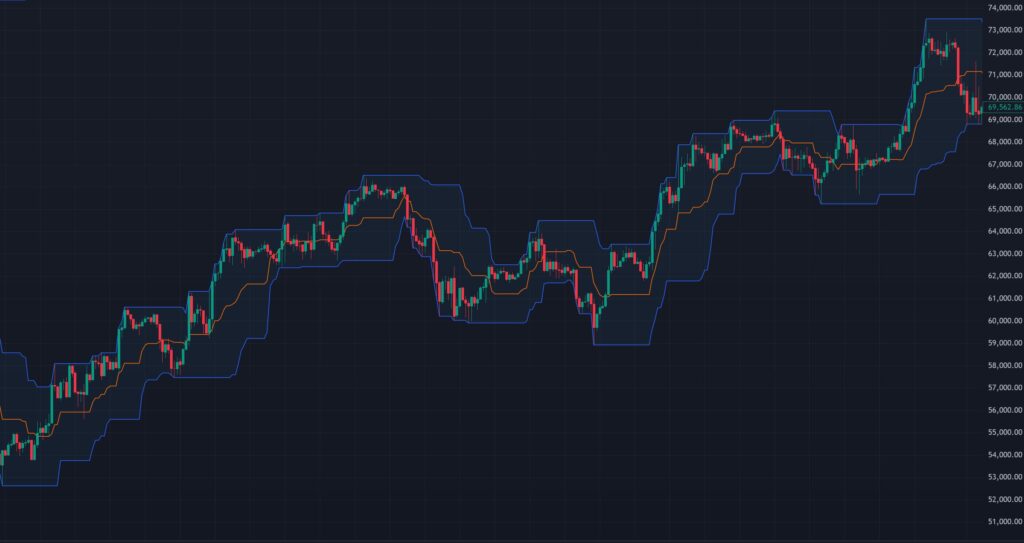The Donchian Channel is a versatile technical analysis tool used by traders to identify trends, measure price extremes, and spot breakout opportunities in financial markets. Developed by Richard Donchian, often referred to as the “father of trend following,” this indicator is simple yet effective, making it a favorite among traders of all levels. In this article, we’ll dive into what the Donchian Channel is, how it works, how to interpret it, and how it can be applied in trading strategies.
What is the Donchian Channel?
The Donchian Channel is a price-based indicator that forms a channel around a security’s price movements. It consists of three lines plotted on a chart:
- Upper Band: The highest high over a specified number of periods (e.g., 20 periods).
- Lower Band: The lowest low over the same number of periods.
- Middle Line: The average of the upper and lower bands, calculated as (Upper Band + Lower Band) / 2.
Unlike indicators that rely on moving averages or volatility measures (e.g., Keltner Channels or Bollinger Bands), the Donchian Channel is purely based on price extremes. The period length—commonly set to 20—determines how far back the indicator looks to establish these highs and lows. This simplicity makes it particularly useful for trend-following and breakout strategies.

How Does the Donchian Channel Work?
The Donchian Channel is straightforward to calculate:
- Upper Band: Maximum price (highest high) over the chosen period (e.g., 20 days or 20 bars).
- Lower Band: Minimum price (lowest low) over the same period.
- Middle Line: (Upper Band + Lower Band) / 2.
For example:
- If the highest high over the past 20 days is $110 and the lowest low is $90:
- Upper Band = $110.
- Lower Band = $90.
- Middle Line = ($110 + $90) / 2 = $100.
As new price data comes in, the bands adjust dynamically. If a new high exceeds the previous upper band, the upper band shifts upward; if a new low falls below the previous lower band, the lower band shifts downward. This makes the Donchian Channel a real-time reflection of price extremes over the selected timeframe.
How to Read the Donchian Channel?
Interpreting the Donchian Channel involves analyzing the price’s position relative to the bands and the channel’s behavior. Here’s what to look for:
- Price Near the Upper Band:
- When the price approaches or breaks above the upper band, it indicates strong bullish momentum or a potential breakout. This often signals the start of an uptrend.
- Price Near the Lower Band:
- When the price approaches or drops below the lower band, it suggests strong bearish momentum or a breakdown. This could mark the beginning of a downtrend.
- Price Near the Middle Line:
- If the price hovers around the middle line, it suggests consolidation or a lack of clear trend direction. Traders may wait for a decisive move toward either band.
- Channel Width:
- Narrow Channel: Indicates low volatility and a tight trading range, often a precursor to a breakout.
- Wide Channel: Reflects high volatility and significant price movement, typical during strong trends.
- Trend Direction:
- An upward-sloping channel (higher highs and higher lows) signals a bullish trend.
- A downward-sloping channel (lower highs and lower lows) signals a bearish trend.
How to Use the Donchian Channel for Trading?
The Donchian Channel is widely used in trend-following, breakout, and reversal strategies. Here are some practical applications:
- Breakout Trading:
- Buy Signal: Enter a long position when the price breaks above the upper band, especially after a period of consolidation (narrow channel). This suggests a new high and potential uptrend.
- Sell Signal: Enter a short position when the price breaks below the lower band, indicating a new low and potential downtrend.
- Example: If a stock trades between $95 and $105 for weeks and then breaks above $105 (the upper band), it could signal a bullish breakout.
- Trend Following:
- Ride the trend by staying in a long position as long as the price remains above the middle line in an uptrend, or in a short position as long as it stays below the middle line in a downtrend.
- Tip: Use a longer period (e.g., 50) for smoother trends and fewer false signals.
- Reversal Trading:
- In some cases, extreme moves beyond the bands may indicate overextension. For instance, if the price surges far above the upper band and shows signs of exhaustion (e.g., low volume), traders might anticipate a pullback toward the middle line.
- Caution: This approach works best with confirmation from other indicators like RSI or candlestick patterns.
- Stop-Loss and Take-Profit Placement:
- For a long trade, place a stop-loss below the lower band or middle line; for a short trade, place it above the upper band or middle line.
- Take-profit targets can align with key support/resistance levels or a predefined risk-reward ratio.
- The Turtle Trading System:
- The Donchian Channel is famously tied to the “Turtle Traders,” a group trained by Richard Dennis using Donchian-based rules. A classic strategy is to buy when the price breaks a 20-period high and sell when it breaks a 10-period low (or vice versa for shorts).
Advantages and Limitations
Advantages:
- Simple and intuitive, focusing solely on price action.
- Excellent for identifying breakouts and trends.
- Customizable period lengths suit various trading styles (short-term or long-term).
Limitations:
- Prone to false breakouts in choppy or sideways markets.
- Lacks smoothing, making it sensitive to sudden price spikes.
- Doesn’t account for volatility beyond price extremes, unlike ATR-based indicators.
Conclusion
The Donchian Channel is a timeless tool that captures the essence of price movement through its focus on highs and lows. Its simplicity and adaptability make it ideal for traders seeking to capitalize on trends and breakouts, while its historical significance—linked to pioneers like Richard Donchian—adds to its credibility.
Happy trading!

